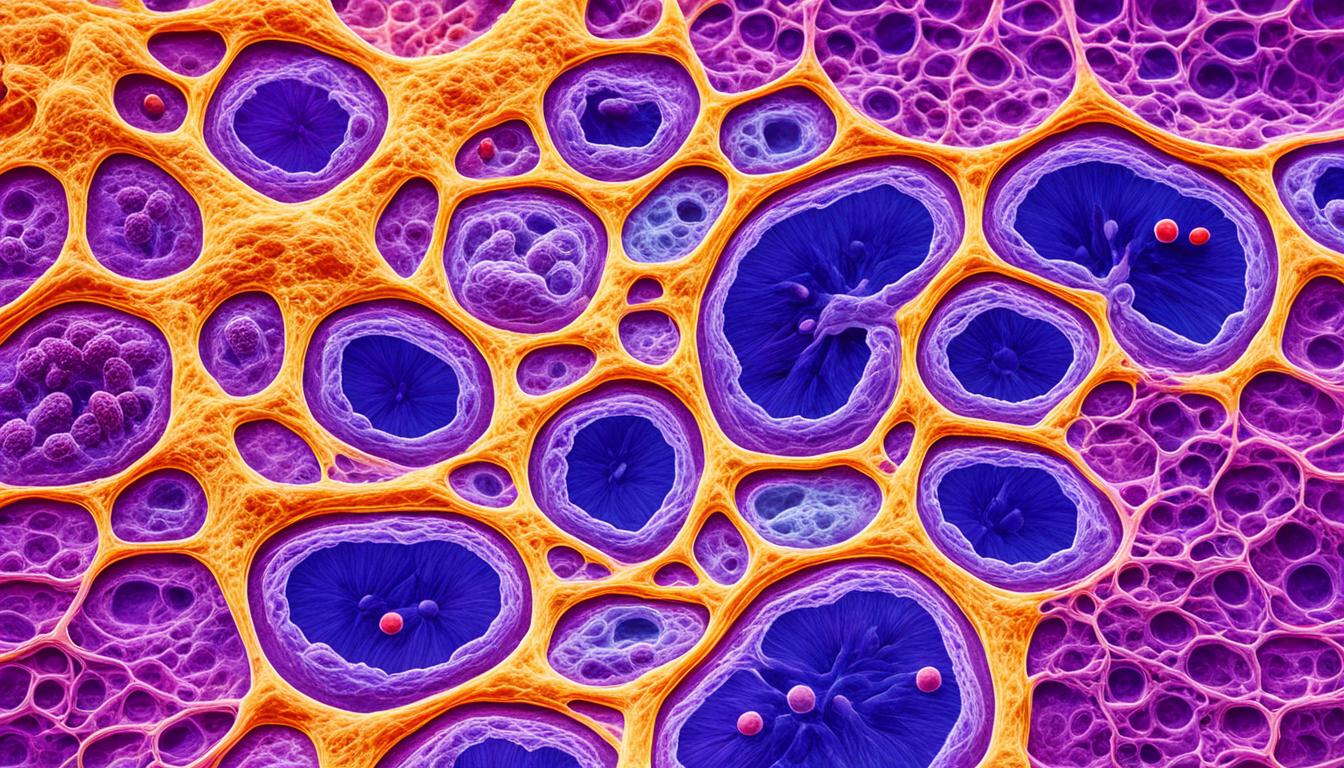Hodgkin’s lymphoma, or Hodgkin’s disease, is cancer that targets the lymphatic system. This system includes the lymph nodes, spleen, thymus, and lymph channels. In this type of cancer, lymphocytes grow abnormally, leading to swollen lymph nodes and body growths.
Lymphoma divides into two types: Hodgkin’s lymphoma and non-Hodgkin’s lymphoma. Hodgkin’s lymphoma stands out because of Reed-Sternberg cells. These are large abnormal cells that signal the disease.
Over time, medical breakthroughs have greatly boosted the outlook for those with Hodgkin’s lymphoma. These advancements include stem cell therapy, marking a significant progress in treatment.
Key Takeaways:
- Hodgkin’s lymphoma is a type of cancer that affects the lymphatic system.
- It is characterized by the abnormal growth of lymphocytes, leading to swollen lymph nodes and growths throughout the body.
- There are two categories of lymphoma: Hodgkin’s lymphoma and non-Hodgkin’s lymphoma.
- Advances in diagnosis and treatment have improved the prognosis for people with Hodgkin’s lymphoma.
- Stem cell therapy is an advanced treatment option that can aid in the management of Hodgkin’s lymphoma.
Symptoms and Causes of Hodgkin’s Lymphoma
Hodgkin’s lymphoma brings various symptoms. These can point to the disease’s presence. They include:
- Painless swelling of lymph nodes in the neck, armpits, or groin
- Persistent fatigue
- Fever
- Night sweats
- Unintentional weight loss
- Severe itching
- Pain in lymph nodes after drinking alcohol
The exact cause of Hodgkin’s lymphoma is still a mystery. It is thought to start with changes in the DNA of white blood cells. These cells fight infections, but when their DNA changes, they start growing out of control. This leads to cancerous growth.
These cancer cells then call on healthy immune cells. They do this to help themselves grow. This process enlarges the lymph nodes and causes other symptoms. Known risk factors for Hodgkin’s lymphoma include:
- Age: Typically diagnosed in people in their 20s, 30s, or over 55.
- Family history: Risks go up if someone in your family had lymphoma.
- Gender: Males get Hodgkin’s lymphoma more often than females.
- Epstein-Barr infection: Having had mono increases your risk.
- HIV infection: HIV positive individuals are at a higher risk.
Knowing these symptoms and risks helps with early detection. Seeking medical help early is important. It improves the chances of successful treatment.
Diagnosis and Treatment of Hodgkin’s Lymphoma
In diagnosing Hodgkin’s lymphoma, doctors often start with a biopsy. They take a sample of the lymph tissue to check for cancer cells. They then use tests like blood tests, CT scans, and MRIs to learn more about the cancer’s stage and spread.
The treatment for this cancer varies. It depends on the type of lymphoma, the stage, the patient’s age, and health. The main goal is to get rid of cancer cells, ease symptoms, and better the patient’s life. Treatments can include chemotherapy, corticosteroid medicines, and sometimes a stem cell transplant.
After treatment, follow-up appointments are key. Doctors need to keep track of the disease’s status and adjust the treatment if needed. Staying with a medical team skilled in Hodgkin’s treatment is critical. They ensure the treatment plan is the best for the patient.
FAQ
Q: What are the symptoms of Hodgkin’s lymphoma?
A: Hodgkin’s lymphoma shows up in different ways. You might notice painless swelling in places like the neck, armpits, or groin. You could feel very tired all the time, run a fever, or wake up drenched in sweat. Losing weight without trying, itching a lot, and having pain in your lymph nodes after drinking are also signs.
Q: What causes Hodgkin’s lymphoma?
A: Doctors are not sure what exactly causes Hodgkin’s lymphoma. They think it might happen when certain white blood cells, lymphocytes, change and start growing fast. Things like your age, family history, and certain infections like Epstein-Barr or HIV can raise your risk.
Q: How is Hodgkin’s lymphoma diagnosed?
A: Doctors use a biopsy to diagnose Hodgkin’s lymphoma. They take a small piece of the swollen lymph node to check for cancer. Blood tests, scans, and a look into your bone marrow might also be needed. These help figure out how far the cancer has spread.
Q: What are the treatment options for Hodgkin’s lymphoma?
A: Treatment can involve different ways to fight the cancer. You might get medicines, like chemotherapy or corticosteroids. Radiotherapy, which uses high-energy rays, can also help. For some, targeted therapies, immunotherapy, or a stem cell transplant may be the best choice. The goal is to kill the cancer cells, ease symptoms, and make life better for the patient.

